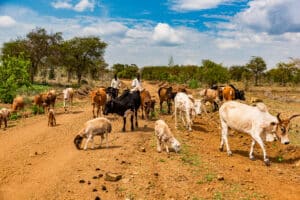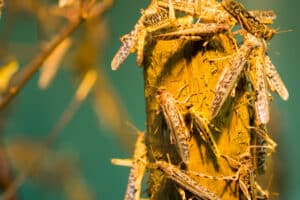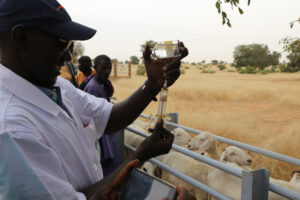Arid and semi-arid land (ASAL) makes up over 80% of Kenya. These areas are home to more than a third of the population and 90% of the wildlife that supports the country’s tourism sector and contributes to 12% of Kenya’s Gross Domestic Product (GDP). Additionally, the ASAL regions host 70% of the National Livestock herd with an estimated value of Ksh. 70 billion ($540 million). ASALs also have the potential to support renewable energy production, such as solar and wind energy.
Despite the significance of ASALs to Kenya’s economy and its renewable energy potential, these areas have the lowest development indicators in the country and are at severe risk of climate change. In response to this, in 2022, the Government of Kenya established the State Department for the ASALs and Regional Development (SDARD) to manage the overall planning and policies for ASALs. Department priorities for the ASALs include the coordination of development, resilience building, socio-cultural integration, and governance.
Since 2018, Commonwealth Alumnus Tabitha Njeri Ndung’u has been the manager of the ASAL Livelihoods Programme in Marsabit County. The programme supports communities in ASAL areas of Kenya to identify and implement appropriate livelihoods strategies for desired outcomes. In this role, she coordinates livelihoods and food security activities and delivers livestock interventions. She is also responsible for working with and strengthening the capacity of local partners and government workers to deliver services to local communities.
Engaging communities to assess disaster risks
Marsabit County is the second largest county in Kenya, located in the central north of the country, and is made up of an expansive plain of ASALs. 84% of the county’s population is reliant on pastoralism (agriculture which deals with animal livestock) and 16% are agro-pastoralists, who also grow crops alongside their livestock.
 The climate in Kenya’s ASALs is changing and undergoing major climatic shocks. Communities are experiencing prolonged droughts and severe flooding, impacting livestock and agricultural production, and livelihoods. Tabitha and her team support communities to prepare for these climatic shocks and identify viable alternative livelihood options as livestock and agricultural production becomes more and more challenging.
The climate in Kenya’s ASALs is changing and undergoing major climatic shocks. Communities are experiencing prolonged droughts and severe flooding, impacting livestock and agricultural production, and livelihoods. Tabitha and her team support communities to prepare for these climatic shocks and identify viable alternative livelihood options as livestock and agricultural production becomes more and more challenging.
One approach Tabitha has implemented is participatory disaster risk analysis (PDRA), whereby she engages the community to analyse and report common risks and hazards, assess their level of vulnerability and existing capacity to manage hazards against the required capacity. The difference between the existing and required capacity then informs the type of preparedness and preventive plans the community needs to reduce the level of vulnerability. This approach has enabled her to work with different communities to understand the gaps in disaster preparedness and co-develop preventative plans.
“The community analyse the hazards that they have, the things that make them vulnerable to disasters. And what are the existing capacities? And what is it that they’re lacking? The difference between what they have and what is required to deal with those hazards and associated risks. When they analyse the gap, then they use this to develop the preventative plans.”
Tabitha and her team work with communities to develop their DRR plans, and encourage them to assess ways in which they can implement certain measures within the community and where they need to engage external support. Currently, communities have implemented more than 30 DRR plans identified through the PDRA process and are receiving support from Tabitha and other organisations to implement and maintain these.
Continual working with the community in this way has also enabled Tabitha to tap into indigenous knowledge, rather than present solutions that may not work in their context.
“Personally, I’ve learned a lot from indigenous knowledge of the community. Because there’s the knowledge from the books, there is knowledge that you have through experiences, and also there is that indigenous knowledge that the community have that can help you. Merging the three makes me more effective and relevant to the context I work in.”
Curbing the spread of disease
Prior to her Commonwealth Distance Learning Scholarship, Tabitha was a private veterinarian, and her veterinary skills continue to play an important role in her work strengthening animal health service delivery in the context of climate change. She notes this is an area often overlooked as being at risk to changing climatic conditions.

Extreme rainfall, flooding and climatic variation results in the breeding of disease causing vectors, increasing the risk of diseases such as Rift Valley fever (RVF) which is carried by mosquitoes, and pests such as desert locusts. RVF causes severe illness and abortion in livestock and can be passed between animals and humans. During rainy seasons, desert locusts produce rapidly and form enormous swarms which devour crops and cause serious agricultural damage.
Attempts have been made to raise the importance of animal health in the context of Kenya’s ASALs and, since 2017, Tabitha has worked with county governments to develop and strengthen animal disease syndromic surveillance systems. This supports the participatory disease surveillance (PDS) system which together act as an important early warning system to identify, respond, and prevent the spread of disease amongst livestock in the pastoral context.
When Tabitha first joined Concern Worldwide, a PDS system was in place but there were several service delivery gaps that needed to be addressed. Consequently, a system analysis was carried out to examine the various pillars of service delivery. Some of the delivery issues identified included technical capacity, human resources, finance, logistics, and supplies. With limited funds to employ trained veterinary and technical personnel, it wasn’t possible to monitor the vast landscape, and so electronic surveillance was introduced to engage farmers in reporting detected diseases using a mobile phone app. Following reports from the community, a team of veterinarians was is constituted to investigate these reports using PDS tools. However, the technical staff lacked capacity to effectively investigate the reported diseases and capture, analyse, and present data to inform constructive actions to tackle diseases.
Tabitha worked closely with the government to develop a training and refresher course to bridge this gap and re-engage participants. This involved training technical personnel on PDS concepts and basic computer analysis to improve data input, analysis, and reporting to strengthen the use of e-Surveillance. Using a central electronic system to manage the data, counties can now produce reports that monitor trends in diseases over time and identify and inform routine preventions, such as vaccinations, which can then be rolled out by country veterinary officers. Tabitha and her team now provide quarterly follow ups on the usage of the system, and help the county teams to reflect and develop action plans to enhance disease control. Some of the plans have included increased PDS, training community disease reporters, roll out of disease vaccinations and treatment, and stakeholder coordination.
Co-producing knowledge on patterns of disease
Tabitha and her organisation have employed a system strengthening approach in engaging with the government and local community. This has involved analysing the existing gaps and supporting the government to address these within the provision of existing legal frameworks. The 2013 Veterinary Surgeons and Veterinary Paraprofessional Act outlines the role of different stakeholders, including the government, the private sector, and animal owners, in animal health service delivery. Participating in this existing structure is an important way for Tabitha to collaborate and introduce change.
“In creating a sustainable change within a system, you use the existing system, because in system strengthening, you don’t create a parallel structure. You work within the existing structure and then you continuously strengthen based on the identified gap(s).”
Through different forums, Tabitha has shared ideas and worked closely with stakeholders to identify, develop, and implement viable interventions. This has included tapping into wider knowledge and experiences and supported joint planning workshops and development of relevant animal disease control strategies and policies. Tabitha also stresses the vital role that communities play in sharing their knowledge and feeding into and influencing projects as they evolve.
One project Tabitha is proud to have delivered through collaboration and community engagement is a handbook which maps and describes common animal diseases in ASALs. As part of the animal disease surveillance, it was important for the veterinary and technical personnel gathering and inputting data to know how farmers and community members tend to describe or refer to diseases, without using veterinary terms or language.
“You have veterinary knowledge from school, but how do you understand the indigenous knowledge, community knowledge? Because for you to undertake any diagnosis, you need to appreciate what you know about the disease and how the community describe that disease for common understanding and effective response. The handbook helps you to blend that knowledge.”
Working with her team, Tabitha compiled information on common diseases in 5 ASAL counties, aligning veterinary knowledge with local and indigenous terms. The handbook produced following this work is aimed at technical and veterinary officers, ASAL communities, government workers, and non-government organisations delivering projects in these areas to enhance understanding of common diseases, support communication and preserve knowledge. In compiling the handbook, Tabitha and her team also appreciated the variation in occurrence of different types of diseases across the counties her team worked with.
As well as being an educational tool, the handbook has an important function in reducing instances of misdiagnosis which can have a significant impact.
“Over time new staff join and because they don’t have that local knowledge, there are a lot of misdiagnoses. You find that somebody is diagnosing this disease as this [other disease] and then before it is corrected, you have lost a lot of livestock and that is loss of livelihood.”
With the handbook in place as a living document to be updated as new diseases or variations are detected, Tabitha hopes it will support the training and development needs of new and existing workers.
Piloting an e-voucher scheme for animal health service delivery
Animal disease surveillance and detection requires access to animal clinical services and treatment. In Kenya, animal health services were privatised in the 1980s, meaning that communities are required to pay to access animal healthcare.
 Due to financial hardship and uncertainty faced by those living in the ASALs, not everyone is able to pay for treatments such as de-wormer or vaccinations, and as such may not treat detected diseases. To support famers, some organisations have flooded the market with free drugs and veterinary supplies, which has conversely weakened the local market system and its control on counterfeit drugs. Local retailers also stock supplies which has led to an increase in antibiotics misuse in treating animal diseases.
Due to financial hardship and uncertainty faced by those living in the ASALs, not everyone is able to pay for treatments such as de-wormer or vaccinations, and as such may not treat detected diseases. To support famers, some organisations have flooded the market with free drugs and veterinary supplies, which has conversely weakened the local market system and its control on counterfeit drugs. Local retailers also stock supplies which has led to an increase in antibiotics misuse in treating animal diseases.
To encourage community interaction with the local market, Tabitha has been involved in the pilot of an e-voucher scheme. Through the scheme, veterinarians registered with the Kenya Veterinary Board are supported to provide private veterinary services through links with farmers in remote areas of the county. In this model, subsidised treatment costs are available to poor farmers and those on higher earnings are encouraged to pay full price for services to fund the subsidy. As a result, farmers appreciate the quality of veterinary services provided and have gradually improved their interaction with veterinary practitioners, instead of depending on NGOs or buying drugs to treat for themselves. Veterinarians participating in the scheme also receive further intensive training on how to diagnose disease, prescribe treatment, and key messaging to farmers such as advice on the withdrawal period following treatment.
The pilot received positive engagement from both veterinarians and community members. Despite having to pay for treatments, the additional training provided on veterinary diagnosis and when to end treatment was well received by community members, who appreciated the quality and tailored service of the scheme. In addition, community members valued the fact that they only received and had to pay for the quantity of drugs or supplies that they actually required. The pilot has now been scaled up and delivered in more counties in Kenya as well influencing the livestock emergency guidelines on modalities for provision of assistance to communities during emergencies.
Applying scholarship learnings in real time
Tabitha began working with Concern Worldwide in an officer role at the start of her studies. Studying via distance learning alongside full time employment enabled her to implement what she learned during her course immediately and incorporate tools, theories, and concepts into her work.
Through hard work and by acquiring the relevant knowledge and skills during her studies, she was promoted to her current manager position, and is proud of the work and impact she has achieved in the role.
“One of the things that I love about this scholarship and my studies at RVC is that it provided us with the opportunity to think broadly. I might be looking at a challenge at work and there’s a concept that I’ve studied that I can apply, and it helped me solve a lot of problems. Over time, I was able to grow and then later I think I proved that I had the capacity for a manager position.”
Tabitha Njeri Ndung’u is a 2014 Commonwealth Distance Learning Scholar from Kenya. She completed a MSc Veterinary and Epidemiology and Public Health at the Royal Veterinary College.


